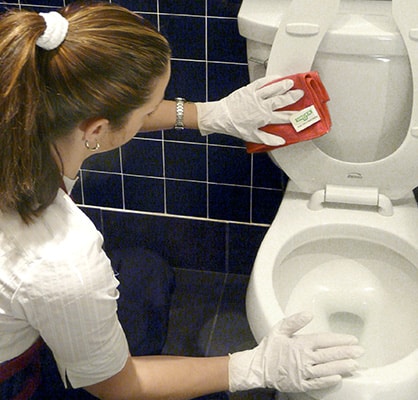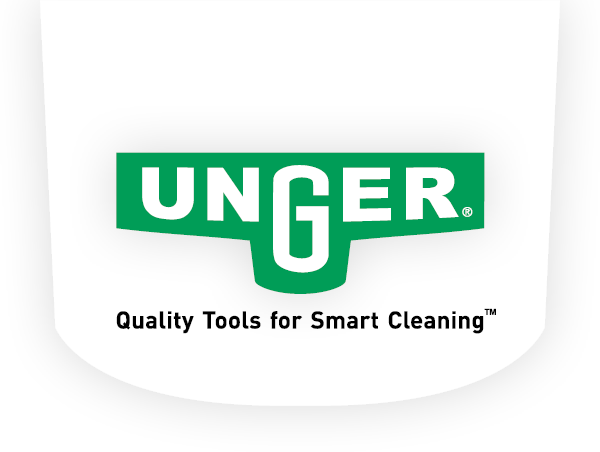NEW! Powerful Nano Filtration with Unger's HydroPower® Nano See The Product

Microfiber Cloth Cleaning for Controlling Infectious Disease Spread
Now more than ever it is critical to truly clean with microfiber cloth cleaning technology to complement disinfecting efforts, as when cleaning and disinfecting processes are combined, you achieve greater success in preventing the spread of infectious diseases. While cleaning processes do not kill germs, they are effective in removing germs and dirt from surfaces. By removing the germs prior to disinfecting, you’re lowering their numbers and the overall risk of spreading infection in your facility. But to accomplish the greatest removal of germs, you’ll need to use the right tools for cleaning high touch surface areas. Here’s where microfiber technology becomes essential in your cleaning and disinfecting protocol.
Understanding Microfiber Cleaning Technology
Microfiber is a synthetic fiber constructed of a super fine blend of polyester and polyamide or nylon. The finished microfiber product is made up of thousands of tiny strands that are each 10-50 times smaller than the diameter of human hair, so small that the human eye would be strained to see them without a microscope. When woven together these strands create a surface area covered with millions of spaces between the fibers to trap moisture, dirt and debris, making it a superior cleaning technology to other materials on the market.
Further aiding microfiber’s cleaning effectiveness are the strands’ curled ends which are capable of extending into the smallest cracks and crevices – the perfect hiding spots for contagious germs – attaching themselves to the microscopic dirt particles. Once picked up, the germs and dirt are trapped inside the cloth or pad. Compare this to traditional cotton cleaning cloths and mop heads which are constructed of significantly larger fibers. Cotton’s fibers are far too big to reach into tiny areas and instead wind up simply pushing around surface dirt and germs.
Research has also shown that static charge aids in the effectiveness of microfiber cloth cleaning. With millions of microfibers brushing each other, the resulting static charge attracts dirt and germs. Although there is only a microscopic amount of attraction between a single microfiber and one dirt particle, when you think about the fact that there are millions of microfibers in a cloth or pad, the attraction expands exponentially. Only when the microfiber cloth or pad is laundered does the static charge break and release the trapped dirt.
Commercial Grade Microfiber Cloths for Cleaning
Cloths marketed as “microfiber” can vary widely in the size of the fibers they use and consequently, their cleaning effectiveness and longevity. For example, heavy duty microfiber cloths are designed to withstand heavy-duty commercial washing cycles, to uphold in facilities that clean in multiple shifts, 7 days a week and endure approximately 1500 wash cycles. A medium duty microfiber cloth would be used more so for 5-day-a-week cleaning operations and multipurpose surface applications. These cloths would hold up for approximately 1000 wash cycles. For daily dusting tasks, light duty microfiber cloths have a shorter product life, lasting up to 500 wash cycles. In short, there is a variety of microfiber cleaning cloths available to meet the needs of your facility and cleaning protocols.
Microfiber Cloth Cleaning Benefits
Simply put, microfiber is one of the most important developments in cleaning technology in years. Microfiber cloths can help you lower the risk associated with harmful contaminants, improve your facility’s image at the lowest possible cost and reduce occupant complaints. Other benefits of microfiber cloths vs. cotton cloths include:
- Ideal for dusting, polishing and scrubbing high touch surfaces
- Four different grades to choose from for any cleaning task
- Double-stitched edges withstand repeated washing cycles and tough cleaning applications
- Absorbs over 6 times its weight in water and collects fine dust through static charge
- Color-coded cleaning system reduces cross-contamination, improves performance
Microfiber Mops for Floor Cleaning
According to a study published by the American Journal of Infection Control, microfiber mops removed far more microbes than standard cotton string mops. This finding amounted to a difference of 95% removed microbes with standard detergent using a microfiber mop, while only 68% of microbes were removed with standard detergent and a cotton string mop. Like microfiber cloths, the technology and ease of use will produce a cleaner, healthier facility when used as part of your floor cleaning system and/or restroom cleaning system.
Using a Color-Coded Microfiber Cleaning System
When microfiber cloths and mops are part of a color-coded cleaning system, the superior microfiber technology combines productivity with the sanitation benefits of visual coding to prevent cross contamination. For example, workers can use red microfiber cloths in the restroom, green in the kitchen and food service areas, yellow in specialty areas and blue for general and light office cleaning. It’s up to you to customize a color code system that works for the unique needs of your facility, whether using it for high touch surface cleaning or as part of your floor cleaning system. No matter how you customize your system, the result is reduced cross contamination that leads to cleaner, healthier facilities.
Cleaning Microfiber Cloths and Mop Heads
Microfiber cloth and mop care labels provide helpful information that can save you time and money. Best practices for regularly cleaning microfiber cloths include:
- Water Temperature: Wash the microfiber in water no warmer than 200 degrees (95 Celsius)
- Drying: Tumble dry the microfiber in low heat
- Ironing: DO NOT iron the microfiber (the heat will melt the fabric and make the cloth unusable)
- Bleaching: No bleach product should be used including detergents with bleach or fabric softener
More Than Ever, You Must Truly Clean with The Right Tools
During these challenging times, we at Unger want everyone to stay safe and clean wherever you can to reduce the spread of Coronavirus and other infectious diseases. As your own facility takes the necessary steps to ensure the safety of your property, employees, customers and visitors, we’ve provided a list of recommended commercial cleaning tools and technologies for reducing the risk of infectious disease spread.
